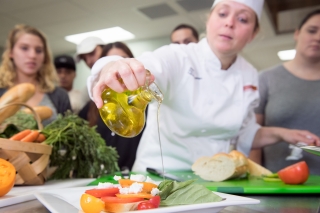
Fun Games Help Students Learn Food Safety and Sanitation Facts
29 January 2021Learning temperatures and microorganisms made easier with creative matching games for students.
By Dr. Jennifer Denlinger, CCC, CHEP
Teaching in a culinary classroom requires a different approach than purely academic lecturing. Young culinarians are interested in a career demanding vast amounts of knowledge, skill, creativity and drive. These desired attributes are then combined, honed, and transferred to a tangible and edible product. All these aspects help make someone successful in the culinary field and do not necessarily lend themselves to a non-kinesthetic note-taking session.
One culinary management student said that “open interactions where opinions are asked” is better to learn and remember correct facts. The student also said “boring” lectures are harder to focus on and learn from. This student said what we all know: engaging students in information-laden courses can be difficult.
However, the emerging culinary arts field has increased the demand for knowledge possessed by chefs. And, the foodservice industry has now put pressure on culinary students to have both a skills-based training and solid academic background that requires a great deal of memorizing facts and figures.
So, how do you engage students who enjoy hands-on activities with memorization? Let’s begin with the facts and figures required in a Food Safety and Sanitation Class and two of its more difficult micro subjects, temperatures and microorganisms. In my experience, these are the topics students struggled with most.
This class contains a lot of memorization including many temperatures – 51 to be exact – and what situations require the use of these temperatures. Also, students must be able to identify microorganisms based on prevention method and source. Students have to pass the Sanitation class to move on to other lab classes. I found students still struggled despite my many attempts at having them memorize everything. So, I created matching games since there are not many hands-on activities or a kinesthetic nature to this subject.
At the time, my classroom had a large whiteboard that stretched across one wall. Whiteboards are magnetic, so I purchased writable magnets to create a matching game. (However, in a different classroom, I had a SmartBoard and it was not magnetic. I devised a way for the matching games to work with colored index cards.)
There are two matching activities, a microorganism review and a temperature learning game. Even though we had lecture/video/questions, etc. as scheduled in the syllabus, these games were done as part of a lesson or on a day when I needed to fill up class time.
Also, I came up with a mnemonic list that would help my students memorize the 23 microorganisms. They are so stupid it is pathetically funny. But when a student says, “Thank you, I’ll will never forget your story about Sam and Ella,” you can high five that one for the win!!!!!
Click here to read a helpful memorization PDF of “Our Favorite Microorganisms.”
To create the matching games, you will need three sets of colored index cards, one game requires two different colors while the other game needs three. These games are played on non-magnetic boards. If your classroom has a magnetic surface, you will need writeable magnets and three different colors of permanent markers.
Two games for understanding microorganisms
Use one color index card and write down the four categories, one per card. Next, use another color index card for the 23 microorganisms, writing each one on a separate card. The third color index cards are for the prevention methods. You will need approximately 33 cards but may have to adjust as there may be two or more prevention methods for some microorganisms.
You now have three piles of cards and two possible games. One game places the 23 microorganisms in their proper category and the other challenge places the correct prevention method with the corresponding microorganism.
If you are using magnets, you will use colored permanent markers in place of the colored index cards, meaning a different color marker represents categories, microorganisms and prevention methods. A handy tip to keep the piles in random order consists of writing their number, either one through 23 or one through 33, in very small print on the back of the cards while they are randomly ordered. If using magnets, write the random-order number very small in a corner.
Game for remembering proper temperatures
Use one color index card and write down the 51 required temperatures. Next, use another color index card for the subject matters, writing each one on a separate card. The game is solved when students can correctly place all the subject matter cards with the corresponding correct temperature. If you are using magnets, write the temperatures in one color permanent marker while using a second color for the subject matters.
A handy tip to keep the piles in random order consists of writing their numbers in very small print on the back of the cards while they are randomly ordered. If using magnets, write the random-order number very small in a corner.
Click here for a PDF description of the game including descriptions of each subject matter and the 51 temperature requirements.
Chef Jennifer M. Denlinger, PhD., CCC, CHEP, is the Culinary Management Program Department Chair at the Poinciana Campus of Valencia College. She is also the vice president of ACF’s Central Florida Chapter. Additionally, Chef Denlinger earned the 2020 Innovation Award, sponsored by CAFÉ and the Idaho Potato Commission, for a creative escape room based on safe food handling procedures.
